

SSH vs SSL/TLS – What are Differences and Similarities? 8 January,2020Jason Parms SSH and SSL/TLS are employing Asymmetric cryptography.
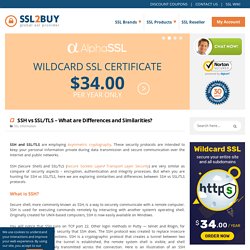
These security protocols are intended to keep your personal information private during data transmission and secure communication over the Internet and public networks. SSH (Secure Shell) and SSL/TLS (Secure Sockets Layer/ Transport Layer Security) are very similar as compare of security aspects – encryption, authentication and integrity processes. But when you are hunting for SSH vs SSL/TLS, here we are exploring similarities and differences between SSH vs SSL/TLS protocols. What is SSH? Secure shell, more commonly known as SSH, is a way to securely communicate with a remote computer. You will notice that SSH runs on TCP port 22. What is SSL/TLS? We combine these two protocols as one because they do much the same thing. Les protocoles d’Internet et du Web – Communication et édition numérique. Ce 8ème chapitre de l’ouvrage Pratiques de l’édition numérique est écrit par Jean-Philippe Magué, maître de conférences en Humanités Numériques à l’ENS Lyon et membre du laboratoire ICAR (Interactions, Corpus, Apprentissages, Représentations).

Nous tenterons de reprendre les éléments importants de ce chapitre technique, en les enrichissant d’exemples et d’informations complémentaires. Tout d’abord, il convient de rappeler la différence entre Internet et le Web. Internet est le réseau qui interconnecte des ordinateurs du monde entier. Comprendre l'ordinateur - C'est quoi SSL, SSH, HTTPS ? Ça sert à quoi SSL ?
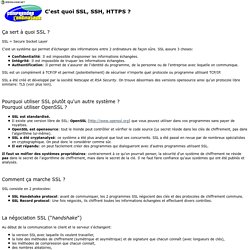
SSL = Secure Socket Layer. Authentification : Oauth2 vs OpenId Connect, qui gagne ? Gartner Reprint. Determine Remote Access Requirements and Tools One of the largest mistakes Gartner sees organizations make when enabling any remote access technology is not defining requirements before purchasing and deploying products.
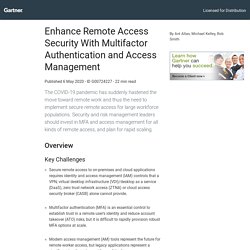
This often results in poor performance, user dissatisfaction, and lesser security as users try to circumvent deployed security solutions in order to have better usability. To mitigate this, we recommended building user personas based on the following four variables: Who is the user and what is their job function? All users are not equal. Implement or Expand Use of MFA Given the greater exposure to phishing attacks and stolen passwords in all remote access scenarios, MFA is required to establish trust in a user’s identity and reduce ATO risks. Smartphone apps and other phone-as-a-token methods can be quickly rolled out to new remote workers; OOB SMS modes are easiest to ramp up, but are not as secure as other approaches. Ldap. Decouple Your Code With Dependency Injection - Better Programming - Medium. James Shore, the author of The Art of Agile Development, put it quite nicely: “Dependency injection is a 25-dollar term for a 5-cent concept.”

The concept is actually really simple: Giving a component all the things it needs to do its job. In general, it means decoupling components by providing their dependencies from the outside, instead of creating them directly, which would create adhesion. There are different ways how we can provide an instance with its necessary dependencies: Constructor injectionProperty injectionMethod injection Constructor injection Constructor, or initializer-based dependency injection, means providing all required dependencies during the initialization of an instance, as constructor arguments: Thanks to this simple change, we can offset most of the initial disadvantages: Even though constructor injection is the preferred way of many DI frameworks, it has its obvious disadvantages, too.
But we can mitigate these problems by using one of the other injection types. OWASP. Hackedu. Secure Code Warrior. Tokens. There are basically two main types of tokens that are related to identity: ID Tokens and Access Tokens.
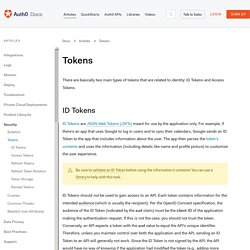
ID Tokens are JSON Web Tokens (JWTs) meant for use by the application only. For example, if there's an app that uses Google to log in users and to sync their calendars, Google sends an ID Token to the app that includes information about the user. The app then parses the token's contents and uses the information (including details like name and profile picture) to customize the user experience. ID Tokens should not be used to gain access to an API. Audience (which is usually the recipient). Access Tokens (which aren't always JWTs) are used to inform an API that the bearer of the token has been authorized to access the API and perform a predetermined set of actions (specified by the scopes granted).
In the Google example above, Google sends an Access Token to the app after the user logs in and provides consent for the app to read or write to their Google Calendar. Gérer l’authentification dans une Architecture Moderne - Partie 1. Quel que soit le type d’application que vous mettez en place, la sécurité et en particulier l’authentification de vos utilisateurs est probablement un de vos points d’attention majeur.

Les architectures modernes peuvent prendre plusieurs formes et différents niveaux de complexité. Mais dans le cadre de cet article sur l’authentification, c'est le caractère distribué de ces architectures qui va nous préoccuper : API Keys vs OAuth Tokens vs JSON Web Tokens - The Zapier Engineering Blog. Adam DuVander / March 2, 2017 For an API to be a powerful extension of a product, it almost certainly needs authentication.
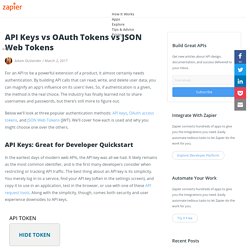
By building API calls that can read, write, and delete user data, you can magnify an app’s influence on its users’ lives. So, if authentication is a given, the method is the real choice. The industry has finally learned not to share usernames and passwords, but there’s still more to figure out. Below we’ll look at three popular authentication methods: API keys, OAuth access tokens, and JSON Web Tokens (JWT). API Keys: Great for Developer Quickstart In the earliest days of modern web APIs, the API key was all we had.